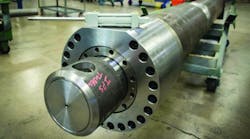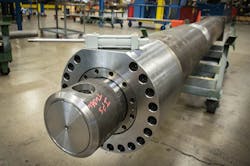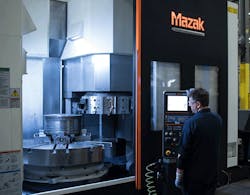Hanna Cylinders increased its throughput up to 40% by streamlining production workflow and by purchasing nine new Mazak machining centers to make machining operations more versatile and easier to set up.
“On many of our Mazaks, we shoot for setup times of 10 minutes or less,” said Laratta. “With our old equipment, setups could take hours. In our production environment, we try to follow a 90/10 strategy for setups. This means we set up for what we run 90% of the time and work in the remaining 10% of unscheduled parts. The success of this strategy is highly dependent on the flexibility of our Mazaks. They allow us to quickly react to any unexpected changes with a lot less disruption in the shop.”
To shorten setup times, Hanna uses simple setups and quick-change tooling/workholding wherever possible. They also use standardized workstations and machining cells, each equipped with all of the necessary hand tools and gauges situated within the machinist’s reach.
Hanna’s part-machining cycle times vary based mainly on part size; cycle times average about three minutes for 4-in. bore cylinder components. On the other hand, cycle times for larger-sized cylinder components might run to eight or 10 minutes, or up to 30 minutes for very large parts.
Part modularity, wherever possible, helps keep machining cycle times short at Hanna, as well as its overall job turnaround times. Although finished parts can be different, many of them start out the same. Therefore, the shop will machine parts to certain semi-finished stages, stock them, and finish machining them to specific needs.
“We had 50 or so machines that encompassed every common brand of CNC, so it was basically impossible to have a guy go from one machine to another,” explained Laratta. “But with the Mazaks, we can move people around wherever and whenever needed, and such flexibility is huge for us. At one time, our situation was extremely detrimental. If, for instance, a machinist that ran a particular machine called in sick, that machine sat until he returned because no one else knew the control. With the Mazak controls, we have people that were trained on one of our QTNs, for example, that, if needed, could run the MTN 1600 or one of the vertical machining centers with very little additional instruction.”
“On our older machines, we’d typically scrap two or three pieces trying to get that first good part,” added Laratta. “On the Mazaks, the first piece is a good one, and we can keep programs right in the machine controls.”




